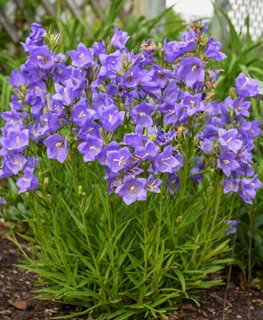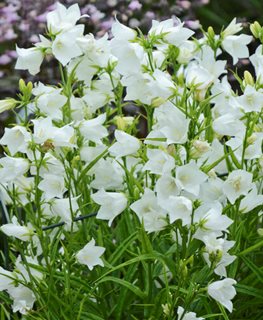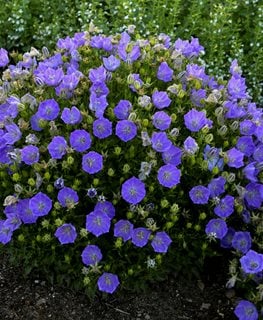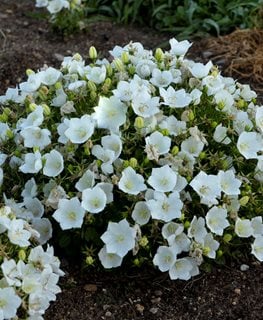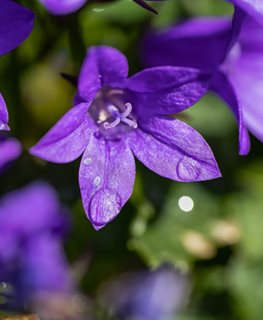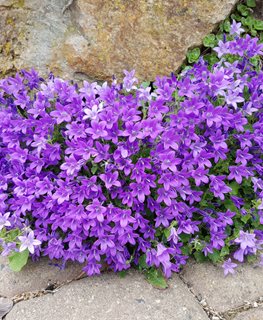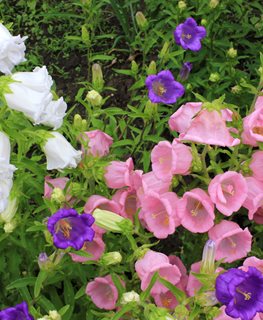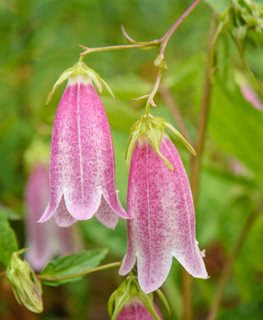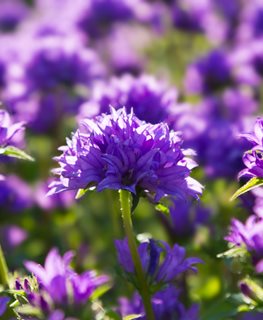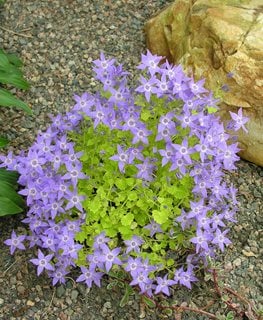HOW TO GROW & CARE FOR CAMPANULA IN YOUR GARDEN
This flowering ornamental plant adds charm to any landscape, from rock gardens to cottage-style borders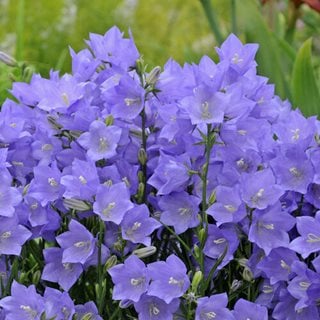
Takion Blue bellflower. Photo: Proven Winners
Campanula, also known as bellflower, is grown for the charming bell-shaped flowers in shades of purple, blue, pink, or white. With over 300 species, Campanula can be found growing in a wide range of habitats throughout temperate regions of the Northern Hemisphere, from rocky alpine cliffs to native meadows.
Long a staple of cottage-style gardens, Campanula comes in an array of sizes and forms, making it a versatile addition to mixed or woodland borders, rock gardens, mass plantings, containers, or as edging along pathways or borders. Here’s how to grow campanula and use this reliable low-maintenance plant in your yard.
On this page: Basics | Planting | Care | Pictures | Frequently Asked Questions | Landscaping Ideas
On this page:
- BASICS
- HOW TO PLANT CAMPANULA
- CAMPANULA CARE
- CAMPANULA VARIETIES
- FREQUENTLY ASKED QUESTIONS
- DESIGN IDEAS
CAMPANULA BASICS
Botanical name:
Campanula spp.
Plant type:
Perennial, biennial, or annual; deciduous, semi-evergreen, or evergreen
Zones:
3-9
Exposure:
Full sun to partial shade
Habit:
Upright, mounding, or trailing habit
Height/Spread:
4 to 48 inches tall and wide
Bloom time:
Late spring to early fall, depending on variety and climate
Flowers:
Flowers are bell-shaped, cup-shaped, star-shaped, or tubular, occurring in hues of purple, blue, lavender, red, burgundy, pink, or white. Blooms can be single or double, facing upwards, outwards, or hanging down.
Foliage:
Serrated heart-shaped, rounded, or lance-shaped foliage is green or gold.
Is campanula toxic?
Campanula is non-toxic to pets and children, though ingesting any plant may cause mild stomach upset.
Is campanula deer resistant?
Bellflower is considered deer resistant, though plants may experience some damage from grazing if other food sources are scarce.
HOW TO PLANT CAMPANULA
When to plant:
Bellflower can be grown from seeds or starts. Plant during milder months in spring or fall to avoid stress from extreme heat or cold.
Where to plant:
Choose a site with full sun to partial shade and rich, well-drained soil. Provide afternoon shade in hotter climates.
How to plant:
Loosen soil in the planting area and amend with compost or other organic matter. Dig a hole slightly wider and the same depth as the root ball. Remove plant from the nursery container and tease out roots if potbound. Place in the hole so the top of the root ball is level with the surrounding soil. Fill in the hole with soil, tamp down gently to remove air pockets, and water thoroughly. Water plants regularly until established. Space plants 1 to 3 feet apart, depending on the variety.
CAMPANULA CARE
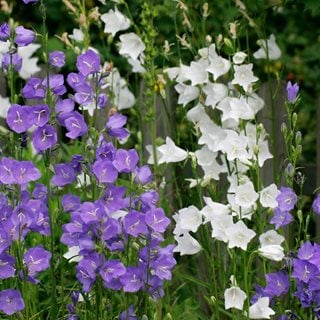
Campanula persicifolia. Photo: imageBroker / Shutterstock
Temperature:
Bellflower prefers warm days and cool nights, and is intolerant of extreme heat.
Soil:
Performs best in rich, well-draining soil with a pH of 6 to 8. Some species are tolerant of poor soils, including clay or rock. For containers, use a high-quality, all-purpose potting mix.
Amendments & fertilizer:
In early spring, apply a balanced slow-release fertilizer according to instructions. Add a thin layer of organic mulch around plants to suppress weeds, retain moisture, and keep roots cool.
Watering:
Campanula prefer moderate water, though some species are drought-tolerant. Keep soil evenly moist but not soggy. Don’t allow plants to dry out completely. Water more frequently during heat and dry spells.
Pruning:
In late winter or early spring before plants show new growth, cut back dead foliage from the previous year. When plants are flowering, deadhead to promote more blooms. Trim off old flowers carefully to avoid removing new buds.
Pests and diseases:
When grown in the right conditions, campanula is resistant to pests and diseases. Pests can include aphids, slugs and snails, spider mites, thrips and whiteflies. Diseases include crown rot, leaf spot, powdery mildew, root rot, and rust.
CAMPANULA VARIETIES
FREQUENTLY ASKED QUESTIONS
Is bellflower an invasive plant?
Most Campanula are not considered invasive, though they can self-sow or spread through rhizomatous roots. Creeping bellflower (Campanula rapunculoides) is listed as a noxious weed in some growing regions, producing creeping rhizomes that are difficult to eradicate.
Is bellflower plant edible?
Many species of bellflower are edible. The roots can be consumed raw or cooked, while the leaves can be eaten as fresh greens. Flowers can be added to salads or used as a colorful garnish.
How long do bellflowers bloom?
Flowering time varies according to the variety and climate. Most bloom over a period of several weeks or months, anywhere from late spring to early fall.
Does campanula come back every year?
Most Campanula are hardy perennials, coming back from year to year. Some species are biennials or annuals.
Do campanulas spread?
Campanula tend to spread vigorously in optimal growing conditions, though most are not considered invasive. To control spread, dig out the outer edges of the plant. Pull out any unwanted seedlings.
CAMPANULA LANDSCAPING TIPS
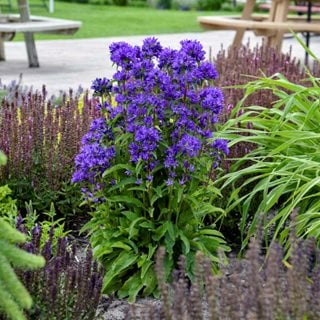
'Bells and Whistles' clustered bellflower. Photo: Walters Gardens, Inc.
For borders and landscapes:
Plant in a mixed border, woodland or rock garden, cottage-style landscape, meadow garden, as edging for pathways or borders.
For slopes and hillsides:
Mass campanula plants along a slope or hillside to help control erosion.
For containers:
Plant trailing campanulas in containers, hanging baskets, or window boxes. Combine mounding or trailing types with other plants with similar growing needs.
There are many ways to incorporate campanula into your home landscape. Here’s how:
- Use a low-growing variety as an underplanting in a rose bed or shrub border.
- Naturalize in a wildflower meadow interspersed with other meadow plants. Read more on creating a meadow garden.
- Use a taller upright form such as Canterbury bells to add height to mixed or woodland borders and cottage-style gardens.
- Mass a ground-cover type along a slope for an ornamental solution to control erosion.
- Plant a ground-cover variety along a pathway as edging for summer-long color.
- Smaller upright or mounding types can be planted near the front of a mixed border in combination with complementary colored perennials such as black-eyed Susan, coreopsis, echinacea or lady’s mantle.
- Add campanulas to a pollinator garden to attract hummingbirds, butterflies, bees, and other beneficial insects.
- Combine a smaller variety of Campanula in a container with other plants with similar growing needs such as creeping Charlie, dianthus, lobelia, calibrachoa, and pansies.
- Use a trailing type in a hanging basket and display on a porch or patio for weeks of continuous color.
- Plant trailing campanula along a rock wall and allow it to cascade over the edge.
- Grow bellflower in a rock garden with other plants such as aubretia, columbine, gold alyssum, sea thrift, and snow-in-summer.
Companion plants: In addition to those mentioned above, these plants also go well with bellflower: allium, columbine, daylily, foxglove, geranium, hydrangea, Jupiter’s beard, kniphofia, lady’s mantle, lamb’s ear, lavender, phlox, and primula.
RELATED:
Our 20+ Favorite Cottage Garden Plants & Flowers
20 Full-Sun Perennials That Bloom All Summer
12 Plants for a Colorful Summer Garden
